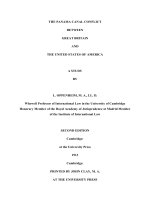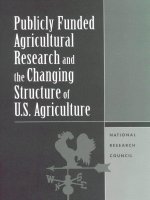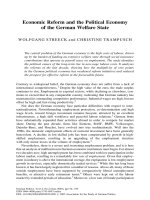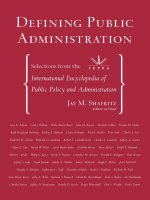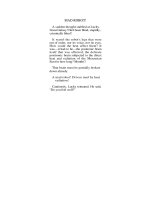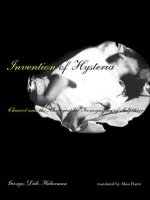street people and the contested realms of public space
Bạn đang xem bản rút gọn của tài liệu. Xem và tải ngay bản đầy đủ của tài liệu tại đây (2.23 MB, 244 trang )
Criminal Justice
Recent Scholarship
Edited by
Marilyn McShane and Frank P. Williams III
A Series from LFB Scholarly
Street People and the Contested
Realms of Public Space
Randall Amster
Foreword by Jeff Ferrell
LFB Scholarly Publishing LLC
New York 2004
Copyright © 2004 by LFB Scholarly Publishing LLC
All rights reserved.
Library of Congress Cataloging-in-Publication Data
Amster, Randall.
Street people and the contested realms of public space / Randall
Amster ; foreword by Jeff Ferrell.
p. cm. (Criminal justice, recent scholarship)
Includes bibliographical references and index.
ISBN 1-59332-066-3 (alk. paper)
1. Homeless persons Arizona Tempe. 2. Homelessness Arizona
Tempe. 3. Public spaces Arizona Tempe. 4. Public spaces Law and
legislation Arizona Tempe. I. Title. II. Series: Criminal justice (LFB
Scholarly Publishing LLC)
HV4506.T8A67 2004
307.3'3 dc22
2004015556
ISBN 1-59332-066-3
Printed on acid-free 250-year-life paper.
Manufactured in the United States of America.
CONTENTS
FOREWORD . . . . . . . . . . . . . . . . . . . . . . . . . . . . . . . . . . . . . . . . . . . .vii
ACKNOWLEDGMENTS . . . . . . . . . . . . . . . . . . . . . . . . . . . . . . . . . . ix
1 INTRODUCTION: Meanings, Methodologies, Means and
Ends . . . . . . . . . . . . . . . . . . . . . . . . . . . . . . . . . . . . . . . . . . . . . . . . 1
2 THEORETICAL PERSPECTIVES ON SPACE . . . . . . . . . . . . .21
3 “TEMPE IS FANTASY LAND!”: Disneyfication
and the Dystopian City. . . . . . . . . . . . . . . . . . . . . . . . . . . . . . . . . 51
4 FACING THE ‘HOMELESS PROBLEM’: Skid Row,
Survival, and the Road to Nowhere . . . . . . . . . . . . . . . . . . . . . . . 73
5 PATTERNS OF EXCLUSION: Sanitizing Space,
Criminalizing Homelessness. . . . . . . . . . . . . . . . . . . . . . . . . . . . 109
6 CASE IN POINT: A Genealogy of the Tempe Sidewalk
Ordinance . . . . . . . . . . . . . . . . . . . . . . . . . . . . . . . . . . . . . . . . . . 145
7 FORCES OF RESISTANCE: Civil Rights Struggles
and the Contested Realms of Public Space . . . . . . . . . . . . . . . . .171
8 CONCLUSION: Localizing the Global, Globalizing the
Local. . . . . . . . . . . . . . . . . . . . . . . . . . . . . . . . . . . . . . . . . . . . . . 203
REFERENCES. . . . . . . . . . . . . . . . . . . . . . . . . . . . . . . . . . . . . . . . . .211
INDEX . . . . . . . . . . . . . . . . . . . . . . . . . . . . . . . . . . . . . . . . . . . . . . . .233
v
FOREWORD
With Street People and the Contested Realms of Public Space, Randall
Amster offers readers a beautifully incendiary book, a book equal parts
erudition and outrage.
The erudition is in evidence throughout Street People; each chapter
of this fine book offers an evocative mélange of intellectual innovation
and critical insight. Gleaning insights and analytic frames from a
remarkable range of perspectives cultural geography, sociology,
cultural criminology, urban studies, critical theory, social history
Randall Amster constructs a theoretical model that is elegantly and
appropriately interdisciplinary. Through this model he develops a
critical, spatial analysis of the city; theorizing the political and cultural
coordinates of urban space, he helps us understand the contested
dynamics by which such space is traversed, occupied, and controlled.
This intellectual sophistication surfaces at another level as well: in
Amster’s thoughtful account of anarchism, and the associated realms of
anarchist history, theory, and methodology. As Amster shows, this
thoroughgoing understanding of anarchism is doubly essential; an
anarchic sensibility animates Amster’s own research, and as much so
many of the people and situations that are the focus of his investigation.
This degree of scholarly breadth and sophistication would be
enough in its own right; but Randall Amster has something more in
mind. He winds this intellectual acumen around and through a
revealing case study, a close account of a city, an avenue, and the social
and economic forces circulating there. As with any good case study,
though, the focus in not on social forces as such, but on human agency,
and human beings. And so Amster lets us hear them talk, lets them
make their case politicians, newspaper reporters, businesspeople, and
especially the homeless folks and “slackers” whom the local authorities
wish most to silence along Mill Avenue. Amster lets us hear from
himself as well after all, as the reader soon discovers, he was as
much a part of the case study, of the spatial conflict he documents, as
anyone else. Put differently, Randall Amster didn’t just write this book;
he lived it. And in this sense Street People presents not only a finely
written ethnography, but an engaging auto-ethnography an auto-
ethnography defined not by self-indulgence, but by its importance as
method, politics, and theory.
vii
viii Foreword
Out of this case study, out of the author’s own involvement in it,
comes the outrage and rightly so. In chapter after chapter Amster
documents the insidious erosion of public space, and with it the
undermining of the spatial foundations on which democracy and
community are built. He meticulously records the mean-spirited
strategies by which public space is today cleansed of the homeless, the
marginalized, and the itinerant; as he shows, the contemporary political
economy of the street is not a pretty one, no matter how many flowers
are planted, no matter how many high-end shops are erected. Most
outrageously, he exposes the campaigns of obfuscation through which
political and economic authorities go about this work, exposing in the
same way powerful groups and individuals lacking even the courage to
admit what they seek to accomplish. In all this, Amster pulls down the
cheap facades of “civility” and “urban redevelopment” that the
powerful have built along streets like Mill Avenue, and reveals instead
emerging configurations of inequality and injustice.
Together, the mix of erudition and outrage, the conflation of case
study method and on-the-street involvement, make Street People a
model of engaged, critical scholarship. A scathing indictment of
economic self-interest and anti-democratic public policy, the book is at
the same time a handbook of hope, a chronicle of effective, direct
resistance to a tightening circle of enforced conformity. If Street People
doesn’t get you angry, doesn’t encourage you to think hard about the
very nature of urbanism, and democracy, and justice if Street People
doesn’t make you want to sit down right in the middle of a Mill Avenue
sidewalk then I’d suggest you read it again, this time with an eye
toward outrage.
Jeff Ferrell
January 2004
ACKNOWLEDGMENTS
Many are due thanks for their assistance and support in sustaining this
project, and while I forbear to list everyone here, a few are notable for
their unique contributions. Pat Lauderdale helped set the tone and
establish the framework for the study, sharpening queries and checking
realities throughout in ways for which I remain deeply grateful. Jeff
Ferrell’s gracious agreement to write the foreword to this volume is
humbly appreciated; his words and deeds continue to inspire the
intellect and incite the imagination. Luis Fernandez was a part of the
story related here, bringing kindred values and collaborative
encouragement that added many dimensions to the work. Leo Balk and
the editors at LFB provided invaluable insight and assistance in
bringing this work to fruition. The Center for Urban Inquiry at Arizona
State University generously provided funding during the crucial early
research phases of the project. Emily Gaarder shared not only
partnership but gentle editing as well; my love and respect are manifest
and offered in kind.
Parts of this work have appeared in journals as earlier versions and
works in progress, for which I am grateful to the respective editors and
reviewers. Portions of Chapter One appeared in the Humboldt Journal
of Social Relations, while aspects of Chapter Two appeared in articles
for both Anarchist Studies and the Contemporary Justice Review.
Much of Chapter Five comprised an article for Social Justice and was
further honed in a talk sponsored by the Free to Camp Coalition, while
portions of the conclusion were developed in a keynote address for
Local to Global Justice.
Notwithstanding the generous support and encouragement offered
and received throughout, any omissions, errata, misconceptions, or
other rough patches are the author’s responsibility alone.
ix
1
CHAPTER ONE
Introduction
Meanings, Methodologies, Means and Ends
Scholars, commentators, and activists alike have at times lamented the
steady erosion of public space, charting its decline along with the
concomitant rise of forces of development, commercialization, and
privatization. An important and pervasive implication of these
processes can be seen in the ongoing trend toward the criminalization
of homelessness, evidenced by the scores of cities and municipalities in
the United States that have enacted anti-homeless laws in the last
decade, including ordinances prohibiting “urban camping,” “aggressive
panhandling,” and sitting or lying on public sidewalks, often adopted at
the behest of commercial interests. The official records, media reports,
and personal experiences connected with the enactment of and
subsequent challenge to a sidewalk-sitting ordinance in Tempe,
Arizona, provide a documentary foundation for this interdisciplinary
study. In addition, participant observations, informal conversations,
and in-depth interviews with street people, city officials, and social
service providers locate the issues within the context of everyday life
on the streets and the unique perspectives of homeless people,
comprising a nascent ethnography of the lived experiences of a
phenomenon that has come to be understood as “globalization.”
Situated among the spheres of legal geography, critical
criminology, and socio-legal studies, this qualitative work seeks to
discern patterns and discover interconnections among: (i) the impetus
of development and gentrification; (ii) the enactment of anti-homeless
ordinances and regulations; (iii) the material and ideological erosion of
public space; (iv) emerging forces of resistance to these trends; and (v)
2 Street People and the Contested Realms of Public Space
the continuing viability of anti-systemic movements, alternative forms
of living, and utopian imaginaries. Drawing upon events in Tempe for
an intensive case study exploring these issues, the work will describe
and document how processes of geographic regulation and homeless
criminalization are interlocking and mutually-reinforcing facets of a
larger frame of social and spatial control often loosely grouped under
the emerging rubric of globalization. In the end, by shining a light on
such processes and patterns, it is hoped and anticipated that this work
will be useful in amplifying a generalized critique of the processes of
globalization and urban development and in promoting action undoing
the same, as well as encouraging the homeless and their advocates to
contest policies of spatial exclusion. Before doing so, however, it is
necessary to place all of these issues in an appropriate personal,
political, philosophical, and methodological context.
Meanings
“We travel on the surface of meaning, which slides a little
further away with each step we take to approach it.”
Pierre Clastres (1994:36)
The production of a “text” is a hopelessly inadequate yet essential
component of any research venture. At some point in time, it
nonetheless becomes necessary to communicate one’s findings,
theories, and analyses, for instrumental purposes in the present as well
as for posterity’s sake. In undertaking such a project, it is important to
specify one’s intentions, understandings, and biases as they relate to the
subject of study – in other words, the “meanings” one attaches to the
subject. By this I do not mean simply “definitions” or “terminology,”
but rather the more subjective aspects of epistemology and ontology
that simultaneously enable and constrain the researcher’s efforts. In
this regard, it is worth noting that “the meanings of things are not
always contained in what is communicated in a text, but rather, the
context, awareness, and experience as tacit knowledge sets the tone”
(Altheide & Johnson 1994:497). Accordingly, the central aim in this
work is to convey a sense of those experiences and moments of
awareness that define the project, and not necessarily to reproduce a
literal translation of the researcher’s findings and theories.
Introduction: Meanings, Methodologies, Means and Ends 3
With this in mind, it is possible to provide an overview of this
project unburdened by the false aim of comprehensive clarity. Instead,
I will indicate here the “spheres of inquiry” that have been explored in
this endeavor, and let the balance of the text speak for itself. Initially,
in further debunking definitional terminology, the oxymoronic nature
of some of the key concepts analyzed here becomes immediately
apparent. For example, this is a study of “street people” – variously
referred to in the literature and media as “transients,” “vagrants,”
“slackers,” or “the homeless” – which immediately raises questions of
how and why people would be associated with the street, let alone live
there. This work also entails an investigation of “sidewalk sitting” –
both as a criminalized activity and a strategy of resistance to authority –
which again raises questions of why and how a person would resort to
sitting in a space seemingly designated for walking. In exploring these
themes, methodological attributes including “participant observation”
have been employed, giving pause as to how one can simultaneously
participate in and observe a given phenomenon, further illuminating the
terminological conundrum implicit in any textual undertaking.
Instead, a glimpse of the spheres of inquiry guiding the project
should prove sufficiently instructive at this juncture. The impetus for
this study grew out of an experiential and academic interest in subjects
including anarchy, community, ecology, utopia, and resistance. The
aim in this early work was to ascertain and describe a coherent vision
of anarchy-in-action that could serve as a tool for deconstructing and
challenging the hegemonic nature of “reality” while at the same time
providing a basis for envisioning and constructing new “realities” that
might exist above, beyond, and within the cracks of the dominant
framework of the State. This quest necessitated an investigation of the
spatial nature of hegemony, since any attempted utopian experiment
would have to be located somewhere. It soon became apparent that the
essence of “open space” for imagining and constructing such endeavors
was sharply limited by the “colonization of the lifeworld” (May
1994:31) that defines late capitalist society in all its totalizing fullness.
Thus, I began to search for spaces that presented opportunities for
contestation and community building, even as I understood that such
spaces were diminishing both ideologically and materially.
By itself, this turn to spatial thinking might have proved an
interesting diversion or addendum to my anarcho-utopian project. But
a series of events in the summer of 1998 moved the work to a new
level, when the City of Tempe announced plans to adopt an ordinance
4 Street People and the Contested Realms of Public Space
that would make it a crime to sit on the sidewalks in the “downtown
commercial district.” No attempt was made at that point to mask the
fact that this ordinance was specifically intended to remove a small
enclave of loosely-associated homeless “slackers” from the rapidly
gentrifying downtown area, or to conceal the intention of commercial
enterprises to “take back” the public spaces of the city from the street
people who were constrained to pass the days there. By this time I had
already made the connection between the people on the streets and
those involved in the anarchist community experiments I had been
considering, such as the Rainbow Family of Living Light, intentional
communities, and squats. I soon began to make a spatial connection as
well, namely that the street people, like the anarchist avatars, often
occupied areas designated legally and metaphorically as “public space,”
and did so in a manner that challenged conceptions of “private
property” and “law and order.” The appearance of these exemplars
reinforced my anarchist beliefs through their overt contestation of
consumerism and commercialization, as well as with the incongruous
nature of their very existence on the streets and sidewalks of the city.
Indeed, this formed the basis of my perception of the street people and
sidewalk sitters as “spatial anomalies” – entities who are “out of place”
in a seemingly well-ordered world.
In this manner, what began as a consideration of anarchy,
community, and resistance had morphed seamlessly into an exploration
of public space, homelessness, criminalization, gentrification, and
contestation. Along the way, elements of social praxis and community
politics began to cohere around this exploration, as the project took on
new life as a subject of academic study as well as a topic of substantial
media attention, legal analysis, and personal commitment. In terms of
documentary material, I have collected and coded reams of media
reports from 1998 up to the present bearing on issues of homelessness,
criminalization, and redevelopment both locally and worldwide, as well
as compiling files of government documents including legislative
histories, city council minutes, and police memoranda. I have also
undertaken an exhaustive review of the scholarly literature on
homelessness and public space, including books, social science
journals, and law reviews. Before analyzing and reporting on such
phenomena, however, it is necessary to consider the methodologies
utilized en route, both in a theoretical sense and as applied to the many
facets of this open-ended, ongoing project.
Introduction: Meanings, Methodologies, Means and Ends 5
Methodologies
Social science inquiry is never undertaken in a vacuum, but is instead
contextual, subjective, and, despite certain claims to neutrality, always
biased. Indeed, it might be said that a researcher without a bias is
either dishonest, disinterested, or dead. Of course, we all bring our
predispositions, hang-ups, and agendas with us when we go out into the
field, and the only things worse than having these objectivity
impediments in the first instance are the frequent attempts by social
scientists to either deny this inherent condition altogether, or to fail to
make such biases apparent in the written reports of their observations.
Good field work should be a product of the researcher’s interests and
subjectivities, or else one runs the risk of embodying the kind of
instrumental rationality and dispassionate logic that qualitative research
methods implicitly reject in their explicit rejection of positivism. In
short, bias is essential to research, and the best way to constructively
incorporate such bias is to make it apparent in our work both in what
we choose to study and in how we present what we have found (cf.
Becker 1970:5,13,77). Some writers, such as Altheide & Johnson
(1994:490), have even gone so far as to formulate this quality of "bias
disclosure" as an "ethnographic ethic." Still other characterizations of
this inherent-bias phenomenon include developing an "epistemological
lens" or "interpretive framework" (Denzin & Lincoln 1994:13), and the
concept of "foreknowledge of the historical situation or context of the
text" that arises in hermeneutics (Diesing 1991:121).
In this regard, as intimated above, my focus initially was on
questions of identity and culture, forms of living, utopian social
movements, and various resistance strategies to the dominant Western
paradigm that is characterized by market economies, private property,
and state authority. Of particular interest in this regard are vagrants,
vagabonds, and other transients and drop-outs, who appear as
picturesque outsiders and gadflies in the ointment of consumer
capitalist society, helping to preserve a discursive space that often
exists beyond the reach of hegemonic forces of social control. In
addition, the quest to maintain a transient identity and a subversive
ideology raises issues of agency and volition that are especially
relevant in the face of diminishing privacy rights and the decline of
public space. Such issues bear further on the question of whether
utopian imaginaries can still be relevant in promoting social
6 Street People and the Contested Realms of Public Space
transformation, or represent mere romantic longings that are rapidly
being mooted by globalization, surveillance technologies, and the death
of open spaces (cf. Mander 1991; Hetherington 1997). The vagabond
and the transient serve as potent exemplars of what a “nomadic utopia”
(Niman 1997) portends, and provide a pertinent bridge between notions
of resistance and the preservation of spaces for the construction of
alternative futures. This celebration (romanticization, even) of
transient and other anti-systemic life-ways is plainly a bias, which I
offer unabashedly as a counter-position to the pro-systemic bias that is
apparent but often undisclosed in much social science.
It is through this theoretical and epistemological lens that I set out
to locate the transient pulse in and around the vagabond haunts of a
particular southwestern college town that, because of its mild climate,
crossroads location, and health food co-op (with its subsidiary ‘Free
Store’) seems to attract more than its share of ‘unsavory’ types. One
can often find these rogues along the town's main drag, huddled under a
kiosk, drumming, and occasionally “spare-changing.” They are also
plentiful at the co-op, pulling in and piling out of their funky buses and
tie-dyed cars, dreadlocked and pungent and happy to hug you for a
smile. Sometimes you see them outside supermarkets and convenience
stores, with buzzed blue hair, multiple body piercings, and unspecified
gender, holding a scruffy puppy on a tattered hemp leash and asking for
a cigarette or directions to the nearest blood plasma donation center.
Every now and then you'll spot a pair sleeping on cardboard boxes in
the shadowy regions of the local schoolyard. Sporadically, they can be
found camping in a remote city park by the river that no longer runs, or
“car-camping” in a semi-industrial section of town that might be known
as “the docks” if the riverbed actually held water.
In conducting this research, my overriding aim has been to
maintain a correspondence between the methodologies employed and
the particular subject under investigation; as Becker (1970:62)
observes, “we should use methods appropriate to the form of our
problem and to the character of the world we are studying.” Methods
employed in anarchic settings such as the street scene or Rainbow
gatherings must be fluid, spontaneous, and open-ended in order to
cohere with the life-ways of the individuals and groups being studied. I
have yet to encounter a discussion of anarchist methodologies per se in
either the social sciences or the body of anarchist literature, although
Jeff Ferrell’s excellent work on “anarchist criminology” (1993, 1999)
does begin to get at some of these issues. Philosopher of science Paul
Introduction: Meanings, Methodologies, Means and Ends 7
Feyerabend is sometimes taken as a methodological "anarchist"
because of his "anything goes" stance, although it would be more
accurate to refer to him as a "pluralist" in the sense of embracing a
multiplicity of methodological possibilities (see Diesing 1991:47-52;
Ferrell 1994:175; Ferrell & Sanders 1995:305). In a review of various
qualitative "interpretive paradigms," Denzin and Lincoln (1994:13)
include feminist, ethnic, Marxist, and cultural studies paradigms
which all have some features in common with what might be termed an
anarchist methodology but do not specifically make reference to
anarchist theories or methods. Some of these connective strands among
interpretive paradigms include a praxis-oriented approach that
emphasizes lived experiences, a critical posture, and the promotion of
emancipatory aims. In the anarchist literature, a recent journal article
by Brian Morris (1998:35) promisingly takes up the subject of
"Anthropology and Anarchism," but turns out to be a substantive
overview of anthropological works with anarchist strands and not an
analysis of the methodologies themselves. Accordingly, in tracing the
contours of an anarchist methodology that is appropriate for a study of
vagrants, transients, and street people, I will rely on (re)sources from
other interpretive paradigms, including various qualitative methods,
"Eastern" modes of knowing, and even quantum physics.
The Researcher's Role
The analysis of research as a social activity, and its implications for
study designs, is embodied in the observation that, "As researchers and
observers become increasingly aware that the categories and ideas used
to describe the empirical (socially constructed) world are also symbols
from specific contexts, this too becomes part of the phenomena studied
empirically, and incorporated into the research reports" (Altheide &
Johnson 1994:489). In other words, as noted above, a certain
methodological and epistemological bias is built into all research,
embedded in the theories and symbols relied upon in framing the
research issues and the experimental or study design. Far from being
avoided as threats to scientific objectivity, such bias is crucial to
understanding the perspective of the researcher and the researched, and
accordingly ought to be included in reports and write-ups as a
necessary counterpart of the “data” itself. As long as we maintain a
veneer of methodological consistency in our observations and disclose
our positions relative to the phenomena being studied, then we have
8 Street People and the Contested Realms of Public Space
achieved a certain “reliability” in the form of forthrightness, by being
up front about our bias(es) and agenda(s).
Bricolage
A bricoleur works with the materials at hand in constructing models,
analogies, and arguments (see Quinn 1996), becoming a "Jack of all
trades or a kind of professional do-it-yourself person" (Levi-Strauss
1966, quoted in Denzin & Lincoln 1994:2):
“The bricoleur produces a bricolage, that is, a pieced-together,
close-knit set of practices that provide solutions to a problem
in a concrete situation, deploying whatever strategies,
methods, or empirical materials are at hand. The bricoleur
reads widely and is knowledgable about the many interpretive
paradigms (feminism, Marxism, cultural studies,
constructivism) that can be brought to any particular problem.
The researcher-as-bricoleur-theorist works between and within
competing and overlapping perspectives and paradigms. The
product of the bricoleur's labor is a bricolage, a complex,
dense, reflexive, collagelike creation that represents the
researcher's images, understandings, and interpretations of the
world or phenomenon under analysis. This bricolage will
connect the parts to the whole, stressing the meaningful
relationships that operate in the situations and social worlds
studied” (Denzin & Lincoln 1994:2-3; see also Clifford
1988:13, on the centrality and subversiveness of ‘collage’ in
modern ethnography).
As Becker (1970:6) similarly observes, such methods involve “the
knitting together of diverse kinds of research and publicly available
materials,” which have the advantage of “allow[ing] human judgment
to operate, unhampered by algorithmic procedures.”
Everyday Life and Studying the Public Realm
An essential theoretical notion often advanced in qualitative
methodologies is that all activity is social, and as part of that network
of relation and communication that we call “everyday life,” research is
likewise implicated as a social activity. In this regard, David Altheide
(1996:8) identifies three primary tenets of social research: (i) the social
world is grounded in a symbolic order; (ii) research is "part of the
Introduction: Meanings, Methodologies, Means and Ends 9
social world we study" (a phenomenon termed reflexivity); and (iii)
"process is key because everything is, so to speak, under construction."
In particular, when methodological techniques such as participant
observation and active interviewing are employed, it becomes clear
how research is both descriptive and constitutive of the social world
and of the nature of “reality” itself. What is asserted in this scheme is
akin to a social constructionist view, and includes the concomitant role
that research techniques play in reflexively constituting meaning (see
Denzin & Lincoln 1994:4) in short, the related notions that research
is a social activity and that everyday life is a legitimate situs of social
research (cf. Ward 1973:11; Thomas 1993:36).
As a consequence of championing everyday life investigations, it is
important to consider the “public realm” as a central site of observation
and analysis, since much of modern life takes place in myriad “public”
settings (although these are not necessarily the same as legally-defined
“public spaces”). Perhaps the best known proponent of such studies is
Erving Goffman, who focused much of his gaze on behavior in public
space as a means of analyzing concepts such as the nature of moral
ordering, norms of conduct, presentations of self, and spatial
arrangements (Goffman 1963, 1971; see also Adler 1994:384, Lofland
1998:2-3). Following Goffman, Lyn Lofland “employed a mixture of
intentional and serendipitous research strategies” (Adler 1994:384) to
explore the spatial and social features of the public realm (Lofland
1973), utilizing methods such as direct observations, interviews,
newspaper stories and columns, and literature from geography, history,
anthropology, architecture, and sociology (Lofland 1998:xii). The
lessons here are that “the public realm is a social territory” (Lofland
1998:3), defined as much by its sense of spatiality as its locus of
everyday life activities.
Intuition, Verstehen, and The Trouble with Maps
In developing an appropriate methodology for a study of transients and
wanderers, it is worth recalling the axiom that "The map is not the
territory" (Wilber 1977:42). In epistemological terms, this leads us to
perceive that all knowledge acquired and disseminated through the
rational processes of intellect, sensation, and linguistics, is only an
"approximate representation of reality [and] is therefore necessarily
limited" (Capra 1991:28). In contrast, knowledge received through
intuitive or mystical processes including non-ordinary states of
consciousness such as meditation, yoga, shamanic trances, psychedelic
10 Street People and the Contested Realms of Public Space
altered states, pranayama (e.g., Weil 1972; Huxley 1954; and Wilber
1977:24 on William James) is often described as an absolute
knowledge that, in Buddhist terms, is the "direct experience of
undifferentiated, undivided, indeterminate 'suchness'" (Capra 1991:29;
see also Hesse 1951). These two great epistemic principles, what Ken
Wilber calls the "two basic modes of knowing" (1977:43), the rational
and the intuitive, comprise a dichotomy that is "sewn into the very
fabric of the universe" (1977:35), and manifests itself in myriad socio-
philosophical antinomies such as appearance-essence, fact-value,
empirical-mystical, and patriarchal-matriarchal. The common
conclusion of the theorists cited in this discussion is that the great
travails and grave perils of civilization are largely due to the misguided
overemphasis of the rational principle almost to the exclusion of the
intuitive, leading inevitably to "the confusion of our perceptions of
reality with reality itself" (Weil 1972:147) that is, to mistaking the
map for the terrain. Thus, despite all of our attempts at validating,
confirming, rationalizing, regularizing, legislating, computerizing,
predicting and controlling, ‘absolute knowledge’ or ‘wisdom’ eludes us
(cf. Nietzsche 1996; Spinoza 1991; Emerson 1969).
In this light, it seems that if we are to "know" something, we must
of course study it, think about it, and analyze it, but we may also
endeavor to experience it. And if we are thereafter inclined to
communicate our experiences, we need to comprehend that words are
abstract, inaccurate, and incomplete (Garfinkel 1987), but that the use
of symbolic forms such as myth, metaphor, poetic imagery, allegories,
paradoxes, and koans can begin to “point” the receiver in the direction
of their own direct experience with the phenomena under investigation
(Capra 1991:43). This, I think, begins to get at the "qualitative" turn to
(re)sources such as "ethnographic prose, historical narratives, first-
person accounts, still photographs, life histories, fictionalized facts, and
biographical and autobiographical materials" (Denzin & Lincoln
1994:6), "visual sociology via photography" (id. at 390), "storytelling"
(Altheide & Johnson 1994:486), and "poetic readings, one-act plays,
and dramatic presentations" (id. at 498). It also begins to explain
sociological turns such as Marx's "early insistence on the transcendent
power of the imagination" (Solomon 1974:467), as well as why "for
most Critical Theorists, the one space left open for resistance was that
of art" (May 1994:26). Such symbolic forms, while still only maps,
begin to connect the rational, intuitive, and direct ways of knowing.
Introduction: Meanings, Methodologies, Means and Ends 11
Another way of making these connections is through an emphasis
on processes of “experiential immersion” (Ferrell 1997:3; Ferrell &
Hamm 1998:13), “empathetic understanding” (Ferrell 1997:10), and
“epistemic enlightenment” (Ferrell & Hamm 1998:14) – sometimes
attributed to and analyzed under the rubric of “verstehen,” which traces
its roots in social science back to Dilthey (see Clifford 1988:35) and
Weber (see Ferrell 1997:10; Ferrell & Hamm 1998:14). By invoking
concepts of empathy, intuition, involvement, commitment, emotion,
subjectivity, meaning, understanding, and experience, verstehen is
deployed not as a crude device that “often smacks of mystification”
(Clifford 1988:35), but rather as a mode of knowing that challenges
dominant forms of rationality and positivism (cf. Garfinkel 1987:3-4).
The aim is not so much to replace the authority of rationality with that
of intuition, but instead to achieve a methodological synthesis that
accords with principles of justice and compassion.
Spontaneity
This phenomenon raises the more general point, noted above, about the
utility of maintaining a correspondence between methodologies
employed and the particular subject under investigation. Methods
employed in anarchistic settings such as the "street" scene, for instance,
ought to be fluid, spontaneous, and open-ended, whereas more
structured, routinized, and systematic methods might be appropriate in
settings where analogous values predominate. As Diesing (1991:52)
notes in discussing Feyerabend's famous remark that "anything goes,"
the true meaning of the phrase is that "the method to be used should be
appropriate to the research situation, including subject matter, theory,
audience, and personality of the scientist." Anarchist social settings, if
they possess any common strands at all, are united in a belief in "the
theory of spontaneous order" (Ward 1973:28), sometimes analogized to
the tendency of biological organisms and communities to be self-
organizing and self-regulating, and always expressed in the belief that
left to their own devices and on equal footing individuals will
voluntarily and spontaneously undertake mutually beneficial
cooperative endeavors (see May 1989:171, discussing the same as the
"a priori" of anarchism). An anarchist methodology ought to abide this
fundament of anarchist social theory and practice.
12 Street People and the Contested Realms of Public Space
Truth, Ambiguity, and Uncertainty
The methods employed in anarchist research are partially informed by
principles often identified with symbolic interaction, which establishes
a framework for interpreting and understanding the "social" realm.
Whereas positivistic methods of analysis focus on objective “Truth” as
evidenced by epistemologically pure “sense data,” symbolic interaction
views “truth” as subjective and therefore susceptible of no absolutely
correct or privileged interpretation. The epistemological implications
are that “truth” is relative dependent upon one's frame of reference and,
accordingly, that there exists no privileged perspective for the
observation and analysis of “reality” (cf. Ferrell 1999:95; Jorgensen
1989:14-5). Thus, in a world where "all knowledge is perspectival"
(Altheide & Johnson 1994:490), all truth-claims are inherently "valid"
(cf. Jorgensen 1989:26-7); as Diesing notes, "since there are many
perspectives there can be many true interpretations. . . . [I]n
hermeneutics truth is irrelevant, and all interpretations are equally
valid." And as Nietzsche (1996:15) succinctly exhorts, "there are no
eternal facts, nor are there any absolute truths."
It should be noted here that I am not unaware of or unmoved by the
potential implications of this position, namely that it appears as a form
of moral relativism that might be used to justify even acts of barbarism
and brutality under the guise of “truth.” The difficulty comes in
attempting to articulate a reasoned basis for accepting some truth
claims and not others – a process that has often worked to the
disadvantage of marginalized people throughout history. For example,
while fascism or racism are certainly not positive social processes, the
question is whether such practices can be dismissed as “untrue” or
“invalid” simply because they appear to serve the ends of oppression
and injustice. It may well be the case that to their practitioners, such
philosophies are not only “true” but are even seen as beneficial and
just. The saving grace of the position articulated here that “truth” is
dependent upon perspective is that the one basis it leaves open for
rejecting a truth claim occurs when a claim to “truth” is advanced in
such a way that it denies other claims – in other words, when a claim is
made to some sort of immutable or totalized “truth” such that other
claims are declared invalid (which historically has of course at times
led to marginalization, colonization, and genocide). Thus, the point of
saying that all truth claims are valid is substantially equivalent to
saying that none are, since this position maintains that any such claims
Introduction: Meanings, Methodologies, Means and Ends 13
are limited in their application to an observer located at a particular
point in space and time.
This relativistic condition requires that we come to accept, even
revel in, a large dose of ambiguity in navigating the social and material
terrain(s) (see generally Ferrell 1993:161 and 1999:91, observing that
“Ambiguity is the stance, the subtext, of anarchism; [it] is the essence
of life”). As Andrew Weil notes in his early work on consciousness
(1972:153), we must achieve an "acceptance of the ambivalent nature
of things." Quantum physics has told us, moreover, that electrons exist
as either/both "waves or particles, energy or matter" (id.), and thus that
there is a fundamental uncertainty built into the fabric of the universe;
in Einsteinian terms, all observations are relative to the observer's
‘coordinate frame of reference’ (cf. Massey 1994:261), and, at the
subatomic level, all interactions can only be expressed in terms of
"probabilities" (see Capra 1991). Similar themes have been
propounded through invocations of “chaos theory,” which holds that
“there are no essential structures and no permanent stabilities governing
space or time” (Arrigo 1998:76). In the context of social science
methodologies, this means that there is little if any point in ever trying
to "prove," "confirm," or "validate" anything; rather, the aim should be
to discern patterns in the chaos, to elicit a dialogue, and to stimulate
thought/action in ways that "point" to our particular conceptions of
"reality" without trying to provide precise, repeatable instructions as to
some generalizable "truth." Ultimately, messages received in this way
tend to inhere deeply if at all, mostly because the truths gained through
dialogue, pointing, and ambiguity are due primarily to the receiver's
own internal processes and not the sender's marshalling of data, status,
influence, or purported methodological rigor.
Symbiosis, not Dualisms
A further aim of symbolic interaction is the uncovering of people's
subjective meanings, and accordingly the theory generally is framed by
the suppositions that (i) people act on the basis of meaning, (ii)
meaning is produced by social interaction, and (iii) meanings are
modified, molded, and refined through an "interpretative" internal
process (Blumer 1969:2). The social realm is seen as a "life-world"
that is interpreted, shared, and intersubjective; meaning is created and
shared by a reciprocity of perspectives in which commonalities in
orientation (e.g., speech patterns, signs and symbols, and “normal
forms”) enable the mutual constitution of reality through processes of
14 Street People and the Contested Realms of Public Space
social communication. In this lexicon, we come to understand the
"process of the life-world" as both a topic (i.e., a subject meriting
investigation) and a resource (i.e., a tool for understanding and
interpreting meanings, symbols, actions). In essence, “symbolic
interaction” offers both an ontological account of the social world, and
an epistemological method for understanding that world.
I would be remiss here if I did not address some of the limitations
of “symbolic interaction” even as I draw upon parts of the theory in
describing an anarchist methodology premised on sociality,
spontaneity, and ambiguity. In a critique of “symbolic culture, with its
inherent will to manipulate and control,” John Zerzan (1994:27)
observes that the development of symbolic forms in human societies
was intimately connected to the “domination of nature” (1994:35), in
the sense that the advent of symbolism and its equation with “culture”
allows a reduction of the world to human abstractions while
simultaneously placing human perception and description (culture) over
and above the processes and practices of non-human life (nature). In
other words, Zerzan perceives that “domination within a society is not
unrelated to domination of nature” (1994:35), and that it is our modern
fixation on seeing the world solely through human eyes and in human
terms that leads inexorably to a rejection of natural processes and the
promotion of hierarchies within society. The extent to which
“symbolic interaction” reifies any of this is still a matter of debate, and
in fact the theory can be deployed to challenge the entrenched
hierarchies of which Zerzan is so acutely and eloquently aware. As
with anything, the ambivalent nature of things means that theories can
be liberatory or repressive, emancipatory or complicit, with the critical
factor being how an idea is used and in what spirit it is deployed.
In generating a sense of “reciprocity” and pursuing socially useful
aims, active interviews (Holstein & Gubrium 1995), participant
observations (Jorgensen 1989), and hermeneutics (Diesing 1991) are
properly viewed as methodological cousins in which the rigid
positivistic lines between observer and observed are obliterated in favor
of a more holistic, inclusive, and egalitarian approach that privileges no
perspective over another and removes the white cloak of objectivity
that seems to me misplaced in any ‘science’ that calls itself ‘social’ –
opening a space for “the dismantling of dualistic epistemic hierarchies
which position the researcher over and apart from research subjects”
(Ferrell & Hamm 1998:14). This is what Dewey perceived in his
insight that "there is no external world separate from us" (in Diesing
Introduction: Meanings, Methodologies, Means and Ends 15
1991:77); as Diesing goes on to note, "The spectator theory assumes a
separation between us and the object to be known, nature or society, so
that our efforts to know it do not affect the object. . . . Against this
Dewey asserted that since we participate in our 'object', society or
nature, knowing involves interaction with the known" (1991:78). Of
course, this is just what the Eastern philosophers, mystics, and more
recently, physicists have been telling us, that the universe is "a system
of inseparable, interacting, and ever-moving components with the
observer being an integral part of this system" (Capra 1991:25). As
Ken Wilber (1977) notes, there is an inescapable sense of symbiosis
that is woven into the very fabric of nature: “Objective measurement
and verification could no longer be the mark of absolute reality,
because the measured object could never be completely separated from
the measuring subject the measured and the measurer, the verified
and the verifier, at this (quantum) level, are one and the same. The
texture of reality is one in which the observer and the event, the subject
and the object, the knower and the known, are not separable.”
Moral Implications
An important question that arises from this analysis concerns the
venerable fact-value (or is-ought) conundrum that has plagued
philosophy, science, and all the social disciplines in between since their
inception (see Harvey 1973:14): Is "human nature" discoverable by
means of "scientific" inquiry such that it makes sense to think in terms
of establishing laws, norms, or principles of conduct? Einstein
(1954:42-5) emphatically avers that:
“Knowledge of what is does not open the door directly to what
should be. One can have the clearest and most complete
knowledge of what is, and yet not be able to deduce from that
what should be the goal of our human aspirations. Objective
knowledge provides us with powerful instruments for the
achievement of certain ends, but the ultimate goal itself and
the longing to reach it must come from another source. And it
is hardly necessary to argue for the view that our existence and
our activity acquire meaning only by the setting up of such a
goal and of corresponding values. The knowledge of truth as
such is wonderful, but it is so little capable of acting as a guide
that it cannot prove even the justification and the value of the
aspiration toward that very knowledge of truth. Here we face,
16 Street People and the Contested Realms of Public Space
therefore, the limits of the purely rational conception of our
existence. . . . For science can only ascertain what is, but not
what should be, and outside of its domain value judgments of
all kinds remain necessary.”
In this sense, it becomes apparent that moral statements of the law-
rule-injunction type are necessarily arbitrary extrapolations from an
untenable conflation of ‘fact’ and ‘value’, sometimes referred to as a
“naturalistic fallacy” which occurs when a normative claim is defined
in empirical terms in other words when we say that something ought
to be because it just is. The problem arises in such Western
cornerstones as social contract theory and classical utilitarianism.
Hobbes, for instance, based his conclusions about human nature and
hence his entire moral theory on observations "confirmed by
Experience" including that then-modern man "rides armed," "locks his
dores," and "locks his chests": "Does he not there as much accuse
mankind by his actions, as I do by my words?" (in Goldberg, ed.,
1995:60). Evidence that men already living under a strong social state
are possessive and suspicious is hardly likely to convince me that the
remedy is a stronger social state. Likewise Mill demonstrates the
tautological nature of his moral claims in the assertion that "the sole
evidence it is possible to produce that anything is desirable, is that
people do actually desire it" (id. at 140). Since utility is taken as the
most basic principle, it cannot be proven by reference to other
principles, and so empirical evidence must be offered to support the
proposition that each person ought to act so as to maximize pleasure
and minimize pain. But what can empirical evidence tell us beyond the
fact that people actually do or do not act in a particular manner? Even
if every person so acted, it still doesn't tell us that people ought to be
acting in this way (consumerism comes to mind in this regard).
Utilitarianism suffers this fallacy precisely because it attempts to
construct “universal” normative foundations on the basis of a version of
human nature that is derived from observations of how people behave
at a “particular” time and place.
This tendency is evidenced prominently in the Western paradigm
as the colonization of the "intuitive" (ought) by the "rational" (is) (see
Nietzsche 1996:45; Spinoza 1991:177; Emerson 1969:21; Thoreau
1965) and notably manifested in the ubiquity and increasing intricacy
of legislation and regulation today. Contrast this with Eastern
cosmologies such as Taoism (Clark 1998; Legge 1962) and Zen (Capra
